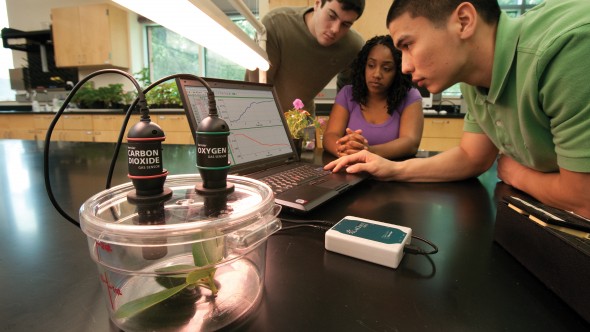 |
Lab Summary This lab has students exploring the influence of temperature on respiratory rate of crickets using Vernier O2 and CO2 gas sensors. The lab uses a combination of more guided inquiry and student-directed methods. Students are initially asked to share what they have learned in class and through outside research and reading to continue to practice hypothesis generation and experimentation skills. Although the question that students will be exploring is dictated by the lab, the hypotheses, procedures and data analysis and interpretation are more student-driven. |
Goals and Objectives
- To understand the process of aerobic cellular respiration in animals.
- To understand how to measure metabolic rates in organisms using respiratory gas sensors.
- To understand how temperature affects metabolic rates of endothermic and ectothermic animals, and more generally environmental influences on the metabolism of organisms.
Scientific Skills - In the context of this lab students
will practice and receive feedback on
- understanding the conceptual relations between a biological process and a quantitative measure of that process.
- developing and justifying an experimental hypothesis and prediction.
- identifying dependent and independent variables in an experiment
- designing an experiment with appropriate positive and/or negative controls
- recording, organizing, summarizing (descriptive statistics and graphing) data in a MS Excel spreadsheet.
- developing statistical null and alternative hypotheses.
- using inferential statistics (a t-test) to analyze data and draw conclusions regarding an experimental hypothesis.
- exploring the importance of replication and repeatability in scientific experiments.
Learning Theory & Pedagogy
The focus of this early-semester lab is
intended to allow students to explore some of the fundamental
aspects of animal metabolism and to discover how this
process is regulated by environmental conditions.
to build on students understanding of how science is
done, by guiding them through some aspects of doing
science, but leaving many of the decisions (hypothesis
formation, aspects of experimental design and
predictions) up to the students. Students
are likely to be more invested in a science experiment
if they are allowed to make critical decisions about
the design and execution. This elicits some
ownership of the experiment to the students,
generating intrinsic interest in the outcome, while
also giving them practice applying important
biological concepts and practicing designing and
interpreting experiments.
Instructional Resources
- An instructor guide which provide lab instructors with pre-lab preparation instructions, suggested materials, learning theory and pedagogical suggestions.
- A student PowerPoint tutorial which introduces them to fundamental aspects of animal metabolism.
- Lab manual appendices that teach students about experimental design, descriptive statistics, graphing and inferential statistics using MS Excel.
- A fun pre-lab homework activity and team-quiz on inferential statistics.
Required Materials
- Vernier Data Loggers and gas sensors (CO2 and/or O2)
- Team lab computers with MS Excel